Soundtrack Science: Making “To Feel Alive” for Percy Jackson and the Sea of Monsters
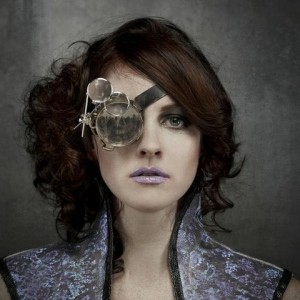
LA artist IAMEVE researched the movie and mythology to write the “Percy Jackson” closing credits song.
Musically inclined moviegoers know that the true climax often occurs right after the very last scene.
That’s when the closing credits roll, and a carefully selected piece of music provides the perfect counterpoint to what’s just occurred onscreen. Whether it’s an original composition or licensed track, the song selection for this moment can make all the difference in how the audience feels about what they just experienced.
The song that caps the 20th Century Fox release Percy Jackson and the Sea of Monsters currently in theaters, is no exception to this rule. Entitled “To Feel Alive,” the 4:06 track by the LA artist IAMEVE helps bring this fast-paced fantasy action film to a stirring conclusion as the end credits roll.
The writing, arranging, recording, and mixing of an end credits song for a major Hollywood motion picture is a serious process – and one that often has to happen seriously fast. For IAMEVE, creating “to feel alive” was a whirlwind process that drew together world-class songwriting skills, sharp collaborators, music supervisor input, a dream-come-true recording session with a 70-piece orchestra at Fox Studios in LA, and a 12.1 surround (and stereo) soundstage mix of her creation — not to mention the unique satisfaction of hearing it play out on a theater sound system at the local multiplex.
For a music production story that truly has it all, follow along as IAMEVE explains the making of “To Feel Alive” from start to finish.
How did you get invited to sing the closing credits song, “To Feel Alive” for the Sony Pictures film, “Percy Jackson: Sea of Monsters”?
I was recording the lead vocals for the film score with Andrew Lockington (the composer) and brought up the idea of writing a song for the end credits. He loved the idea and we brought it to Thor (the director) and Julia Michels (music supervisor). They were open to it, so we went ahead and wrote something to present to them. Thankfully they loved it, as did Fox.
What distinguishes a song written specifically for a movie’s closing credits – what makes this a unique assignment in music and music-for-picture? (Editorial note: SPOILER ALERT in the next answer!)
Writing for closing credits is different simply because what you leave people with is what sticks with them. You need to write in a way that brings resolve to the story and/or a desire for more — in other words the next sequel. Personally, I gravitate towards cinematic songs and am really into fantasy and mythology, which is a big part of the movie.
For this song specifically, I was drawn to the story of Thalia who comes to life at the end. It’s an inspiring moment and leaves you wanting more of her. Giving her a voice felt like a powerful way to connect the ending of the film with Thalia’s quest in the next sequel.
How did you approach writing “To Feel Alive” – what input did the director give you, and what research did you do to form a perspective for it?
Because I was singing “Thalia’s Theme” throughout the score, we focused musically at first trying to incorporate that theme into the song.
Thor had said that he wanted a really strong hook and for it to be uplifting, so I played the chord changes on piano and sang ideas until it felt pretty strong and then I sent it over to Andrew, who tweaked and sent back. Since the chorus was so big, we wanted the verse to be much darker and the pre-chorus to give a nice lift into the chorus.
Lyrically I did a lot of research on Thalia’s character and traditional mythology for inspiration. Ultimately for the lyrics and melody, the main intention for me was to stay connected to Thalia’s story and continue using the song as a way to give her a voice. Arrangement wise, we focused on connecting the sound of IAMEVE with the film orchestration and giving it a real cinematic quality.
Was there an approval process for the song? How did it get reshaped before it had a final OK?
Yes – definitely. When we first played the demo for Thor and Julia it was very rough and they had a lot of great feedback, so we tweaked a few times until they were really happy. Then Julia brought in producers, Brian Liesgang and Cory Enemy, to make an amazing demo to present to Fox.
Once that was approved, we sent it out to the studio, and from there it went through a continuation of tweaks to get it just right in the production. After that we recorded the orchestra and choir before it went into mix mode, which also went through an approval process.
Into the studio — tell us about the recording process. Did you do the vocal at a different time then the orchestra?
Yes, the vocals were recorded separately from the orchestra in a couple different sessions. Most of the track was produced prior to recording orchestra as well. I think there were over 20 layers of vocals, which were recorded partially in my home studio and the mains with my friend Steve Shebby at his studio in Hancock Park.
Hearing a full orchestra at Fox Studios recording a song that you wrote is an experience any artist would aspire to – how did that unfold?
It was over 70 pieces, plus a 40-person choir, and a separate drum session being conducted by Nicholas Dodd — it was huge because it was the orchestra they were recording the film score with.
It was important to have the sound of Andrew’s orchestra, so he made it possible to squeeze in time at the session for the song. Andrew’s arrangements are stunning and Nicholas is the best conductor I have ever seen in my life.
Plus the sound in Fox Studios is phenomenal. The live room is epic and I’ve never seen a control room that big. It was an absolute dream come true. To stand in a room with a full orchestra playing my song – I’ve never experienced anything like it. It makes you realize that, while technology has accomplished some insane sampling options, that there is nothing as breathtaking as a live orchestra.
From there, let’s look at the mixing processes. Were you there for when the song was mixed as a song, and then as a part of the soundtrack? What was unique about seeing a song incorporated into a movie mix?
We did our first mix of “To Feel Alive” with Brian and Cory at their studio in Los Feliz, which I was there for, then Brad Haehnel did the soundtrack mix at Fox Studios. From there, it got sent to the mixing team for theatrical release at Fox, which entailed mixing the song for 12:1 surround sound in theaters. This was a really interesting process to watch and took a lot of work to make a stereo mix fit 12:1.
What was the timeline like for this project? Did it all move slower or faster than you expected?
It went so fast I could hardly breathe! It was very exciting, but a really tight timeline.
We finished writing the song about 10 days before the orchestra was being recorded. I was in London at the time, so I flew back to quickly finish it with Andrew and we produced it with Brian and Cory that week. The very next week we recorded the orchestra, and before that we had to get it approved by Fox before getting the green light for orchestra.
It definitely sounds like a whirlwind. Finally, describe your experience of seeing the movie in an actual theater with “To Feel Alive” on the closing credits – what was surprising/enlightening to you about the final effect, when it was incorporated along with the final product in its intended environment?
Hearing the song in the theater for the first time was very emotional for me. Aside from gushing with excitement, overall I was just thrilled with the way everything turned out.
The most fulfilling part for me has been connecting with the audience and fans of Percy who have been so responsive to the song, posting lyrics and videos and sharing it with everyone. I feel really happy that the song captured something magical and that it connects with people. That’s all we can do: create what feels right and hope it connects.
IAMEVE’s three-part-concept album, The Everything Nothing, debuts later this year. Act One is available on iTunes now.
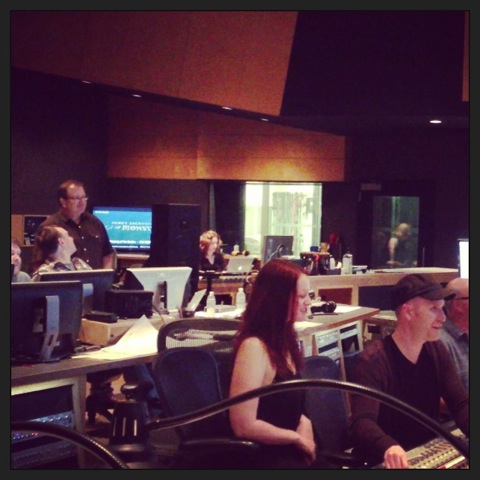
IAMEVE and Andrew Lockington (to the right) in the control room while recording the orchestra on “To Feel Alive”.
Please note: When you buy products through links on this page, we may earn an affiliate commission.







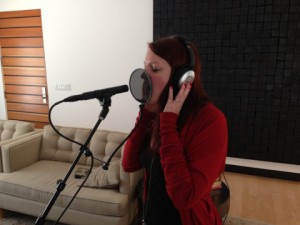
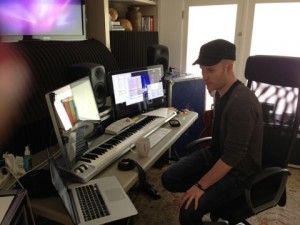
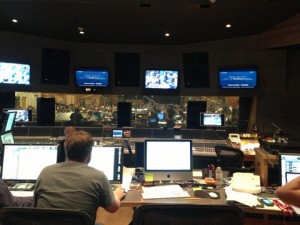
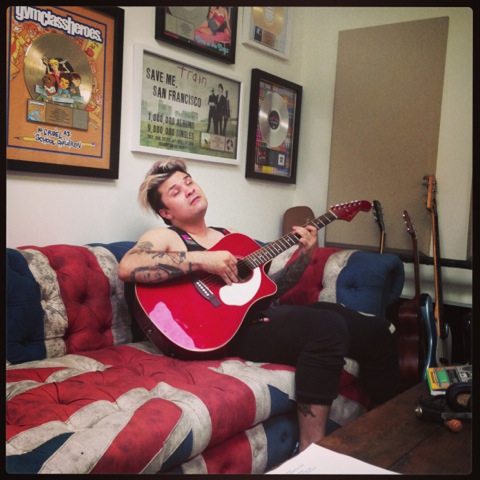
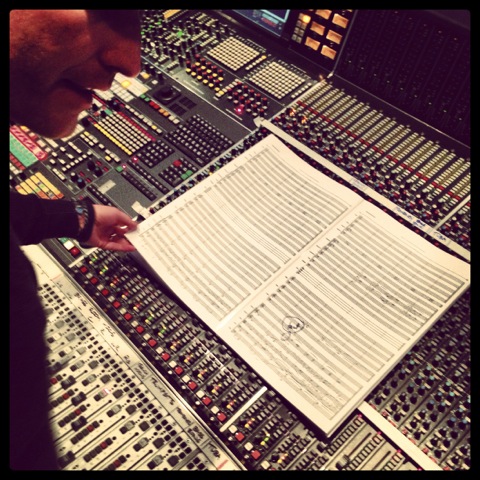
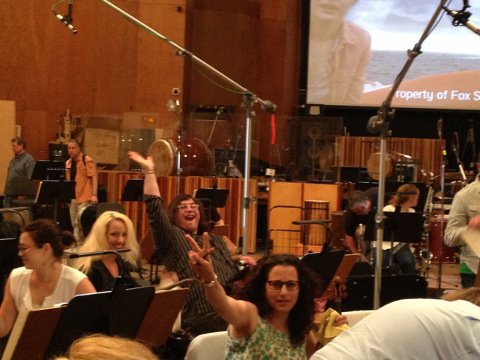
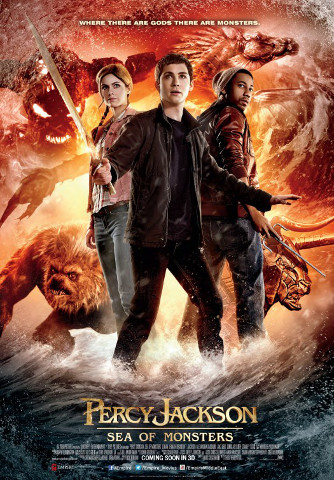
ADELE AND KELLY
January 8, 2014 at 10:19 am (10 years ago)Love this song SO SO much haha